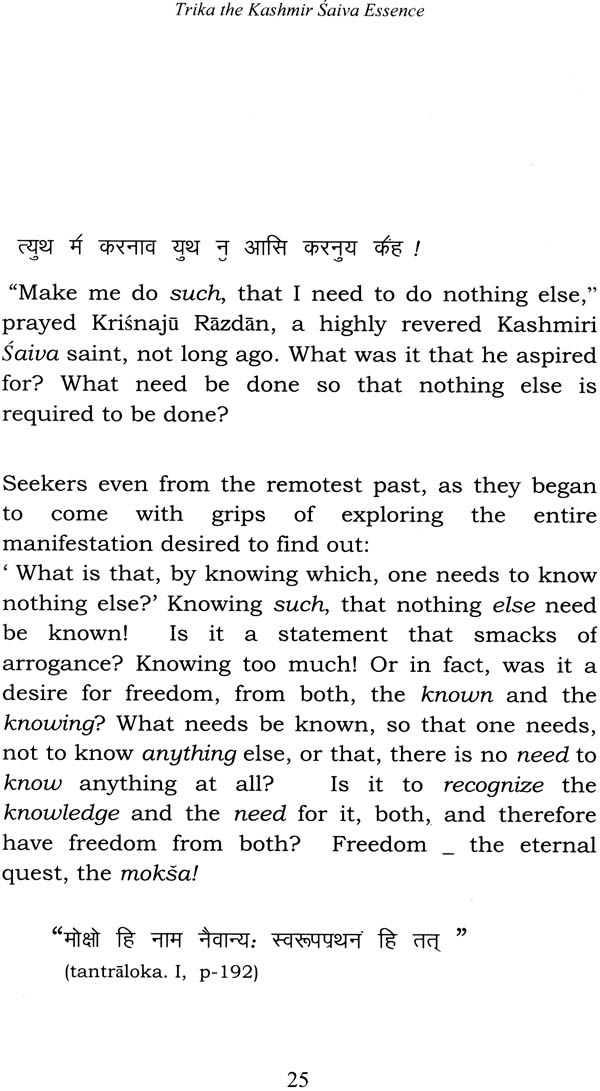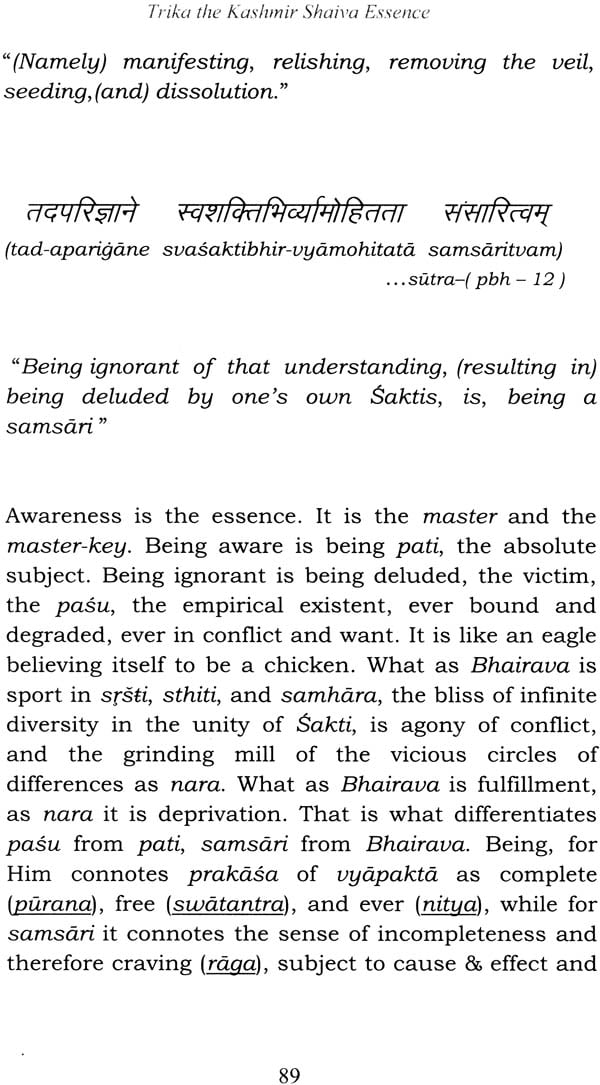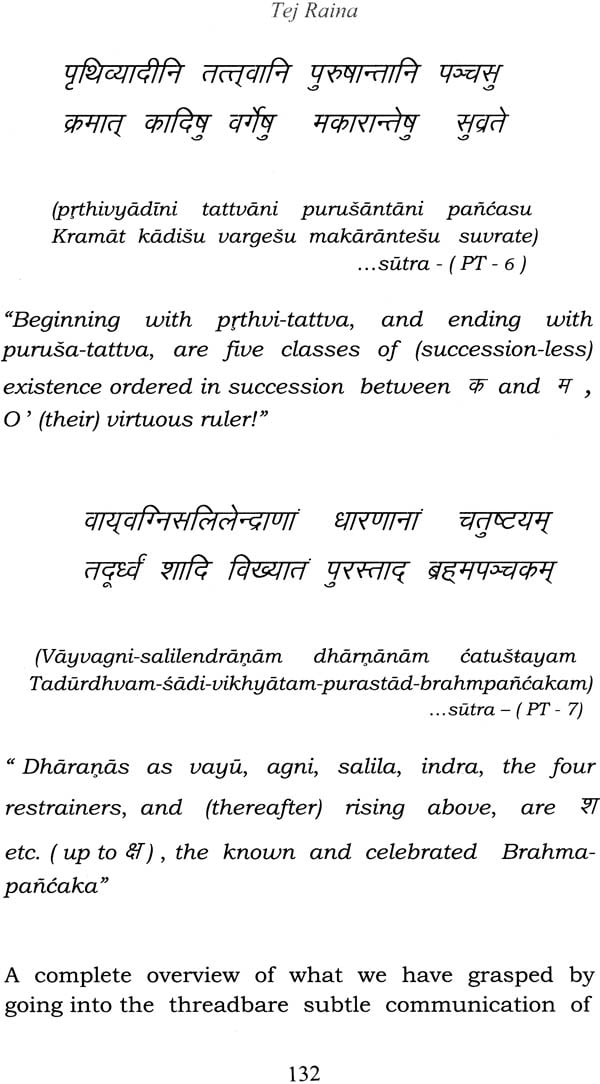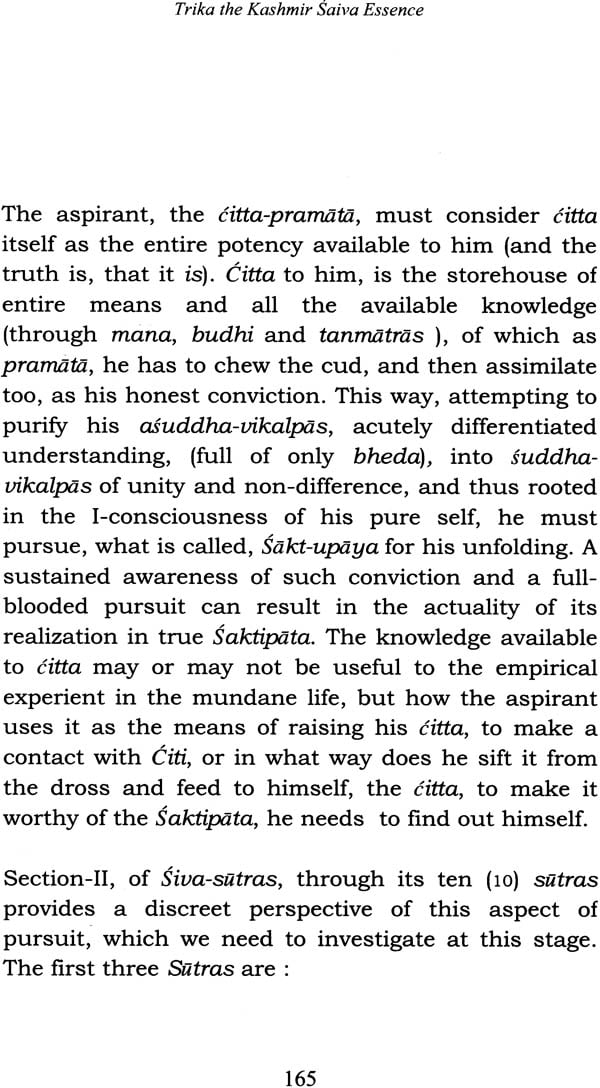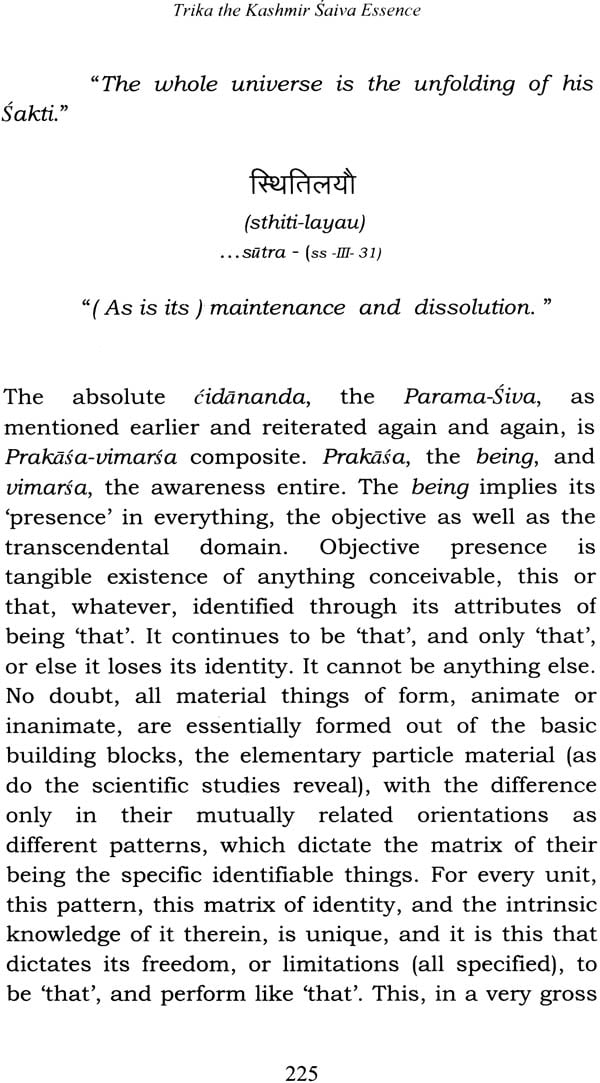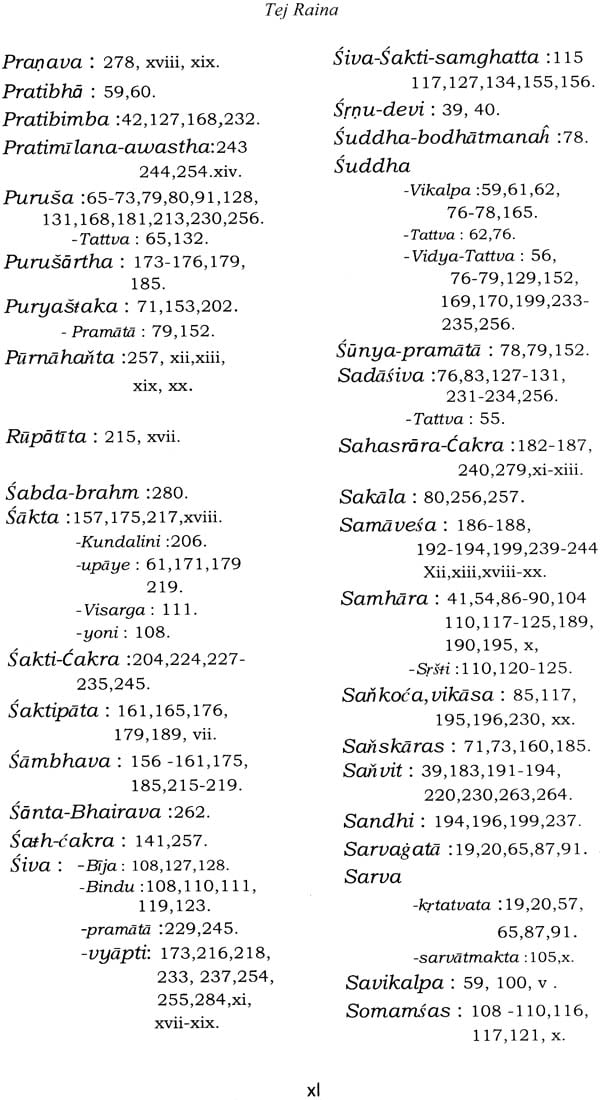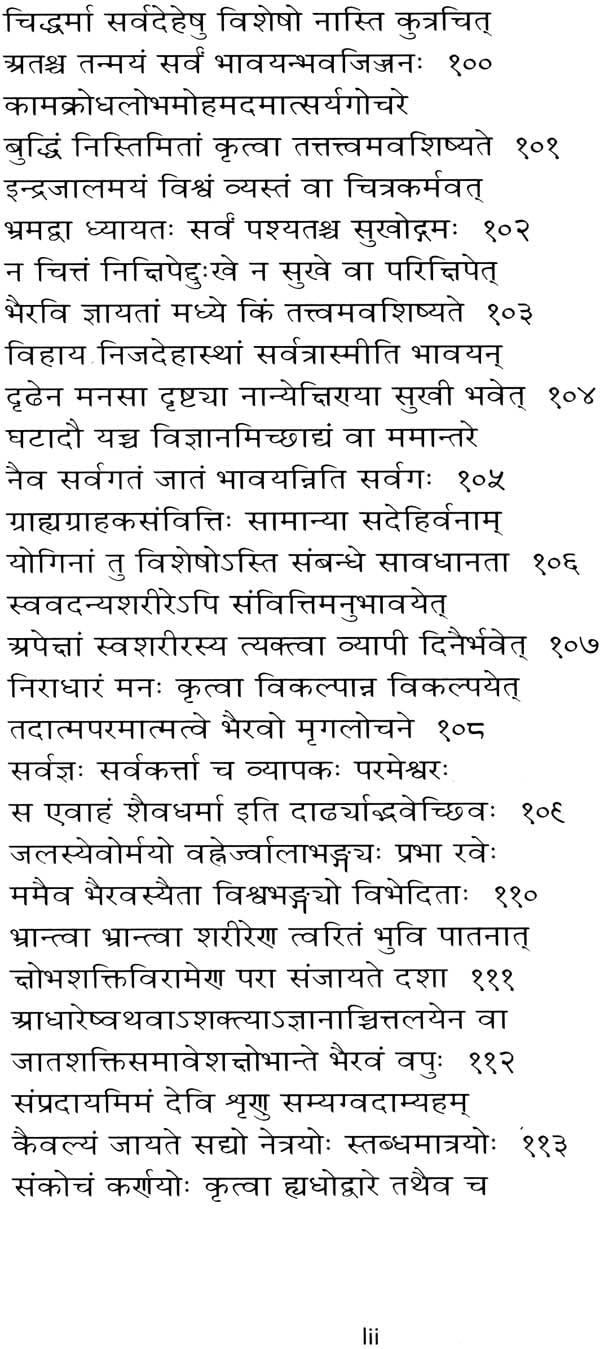
Trika (The Kashmir Saiva Essence)
Book Specification
| Item Code: | NAE737 |
| Author: | Tej Raina |
| Publisher: | Aravali Books International Pvt. Ltd. |
| Language: | English |
| Edition: | 2013 |
| ISBN: | 9788181501615 |
| Pages: | 359 |
| Cover: | Paperback |
| Other Details | 9.5 inch x 6.5 inch |
| Weight | 600 gm |
Book Description
Lofty philosophical subtleties of Trika school of Kashmir Shaiua wisdom shrouded in intricate Sutras, have been unfolded in rational investigative manner for a modern thinker, in a captivating conversational language, by the author Tej Raina in Trika, the Kashmir Shaiua Essence. Beginning with the perceptive experiences each one of us has, he develops a coherent, thought-provoking argument that helps to visualize the profound Trika communication, handed down from centuries to us in the form of Sutras by the seers of profound truth. He uses Sutras as lighthouses to authenticate the perspective he provides for understanding, contemplating upon, and practicing Trika truth. The book can certainly enlighten any serious reader.
Tej Raina, (born 2 February 1942), a college teacher by profession, taught Physics in various government colleges of the Jammu and Kashmir state and at the same time remained associated with literary pursuits, T.V. script- writing, news-reading and ETV program presentation. He also worked as Educational Media Generalist in AIIMS, New Delhi. At present he lives in Jammu busy with his writing and study.
Saiua wisdom of Kashmir is very ancient, and was communicated down the centuries through oral traditions, but recorded in texts giving details of the delicate philosophical perspective, the clues about the actual experiences the sages had, as also the guidelines for the genuine aspirants of the reality, discussing the appropriate ways for such pursuit into the exploration of their true self. Such manuscript-information dates back to about eighth century A.D. with Vasugupta's documentations. Later writings and compilations continued from time to time. Foremost amongst many others mentioned in line are the names of Somarianda, Utpaldeva, Abhinavgupta, Kshernraja, Bhaskara, Varadaraja, etc. The literature comprises basically three kinds, namely Agma, (believed to be direct revelations, handed down orally from guru to Sisya, in utterances as crisp Satras), Spanda, the doctrines sorted out and elaborated upon in detail with interpretations, and thirdly, the Pratuabhiga shastras comprising discussions, arguments and- counter-arguments, with logical interpretations.
My aim in documenting this modest title, 'Trika , the Kashmir Saiua Essence', a humble presentation of the most profound truth, is simply to trace, in a coherent continuity, the basic, the essential communication of Trika wisdom, as I conceive it, and put it before the readers, only to motivate them for seeking a broader and more comprehensive perspective of it. I have attempted to present in this book, how, a contemporary, scientific and rational approach of looking at the mundane reality projects certain baffling aspects of it and raises some nagging questions demanding answers. The very questions that led me to seek answers from the Saiva wisdom which layer by layer peeled off most of the dross my thoughts had gathered and the notions I had installed in my within. I have precisely documented the same line of approach that opened up a perspective for me substantiating each move with Sutras from different Saiva sources. I invite the serious reader to probe deeper and contemplate without any resistance of prejudice to partake of the lofty wisdom of Saiva.
Immense cosmic emptiness (space) is represented by nothing, no known thing at all. We know it as empty, but that does not mean we know it. It truly is unknown. Presence of something may be recognizable, but the absence of a recognizable may be the presence of something else, not discernible by the known means and understanding. Any visible solid is after all not so solid and continuous as it looks, and we believe it is, because, it does not show to our eyes the hollows; it harbors in the most of its within, with sparse punctuation of molecules, and within them similarly, the (so-called) elementary particles. And an invisible odorless gas is not without any content, as it looks. A floating iceberg, in an ocean, on a hot summer day, is a system of three different entities, the ice, the water and the vapor, all of which are objectively the same content, presented differently at the same time. Different is not the content of the three but the placement of their building blocks or rather the empty spaces within them. It is the relative spatial layout of the elementary particles they are made of, which gives them the distinctness of their features and qualities. And what after all, ultimately, is this matter that forms these materials? Who knows! Is vacuum truly empty? Studies in the domain of quantum theory have shown that even at absolute zero ( -2730 C ) temperature, when it would appear that an oscillator has no energy reserve whatsoever, it continues to perform zero-oscillations, with the residual half- quantum reserve of energy, which it always retains, and cannot be taken away from it. This zero-point energy ' (manifesting in Casimir effect, and Lamb- shift perturbations), is an intrinsic property of vacuum. Investigations into subtler objective aspects of vacuum may reveal a lot many, yet unknown, features of it, but, indeterminacy will still persist at the level, where there is non-differentiation between non-objective and objective states. A keen, discerning mind may be able to lay hold on the subtlest of the thoughts or feelings, even when they are just emerging into distinctness of their form, or exist still in their earlier, somewhat vague, formative stage, but can never perceive them in their nursery of un- differentiated levels. On the arrival of a new thought, decay of the earlier thought in its cognitive stage, is clearly succeeded by a seemingly blank, no-thought, mental-space, that precedes the new thought. This blank space provides distinctness to the new thought, as much as it acts as a bosom for the old thought, to go into a sleep of oblivion, but not annihilation. This indeterminate, blank mental space, without any objective character or form, acts like an indefinable and inaccessible field, for the sprouting of the new, and sinking in of the old, discernible feelings and thoughts. Teeming with infinite number of all the un-differentiated thoughts and feelings, that ever existed, or shall ever come into existence, this level of consciousness is indeterminate for mental reach, as it does not possess any discernible thought in it, although, any of the feeblest of the most feeble probes, whatever, can cause any of them to flower forth. Rationality, idealization and other like terminologies, after all, refer to our perceptions of finding an order in the known, and a visualization of the unknown. The known is always limited by the means of knowing, and the means are always objectively defined. Idealization also is possible within the objective references, because our mind cannot perceive except in objective terminologies. This sets a barrier for our resolving faculties mentally, beyond which our known faculties cannot operate. In objective phenomena the means of knowing re- express and re-orient their horizons from time to time. If our 'known' shuffles its presentations, what do we hold on to? What changes have not occurred in our concepts about our own physical world around and within us in just a few past decades, or a few hundred years! And then, how aware are we of the lots of very well-known things, or the most intimate things around us! How aware, for instance, are we about the air surrounding us all the time? An occasional sudden whiff of any aroma, or else, a pressure wave in air presenting itself as some kind of sound, any time, may briefly make us conscious of the medium around us. But do we see the ever- present patterns of the gas molecules laid out all around us in a strictly disciplined mutual relationship, even in the seemingly chaotic flow of all the gases, as also, all the other so-called, abstract things in air that comprise our atmosphere? Can we see or perceive the chaotic crowd of the multitudes of the wave phenomena drowning us every time in them? A beam of light passing just across my field ofVision does not make itself visible to me unless its presence is felt only when intercepted by any material, even dust, that is brightened up by it. Even then, I don't see more than a glare or glint. I don't see the procession at all of the infinitely various packets of energy (if they are packets), the quanta as they are called, in extremely unflinchingly, disciplined patterns, parading in front of me. I do not admire the perpetual dance of an unending host of infinitesimal energy packets, of a specific kind, that presents itself as a colored patch of green in a leaf or red in a petal of rose. What image patterns, the invisible tiny rays of light shooting in the space all around me, carry in the placements of their energy packets mutually, or rather the placements of the gaps in between the energy packets, or actually, the mutual relationships of quanta and gasps remains shrouded in mystery. This objective and non-objective presence of the energy in each of its wave-fronts is not at all visible to me. Only when, an appropriately interacting interception occurs, something may show up. A beam of light starting from an incandescent source of light, and passing through a slide or an exposed film will reveal the image it carries of the slide, if it hits a white opaque screen which acts temporarily as a non-interfering witness to it. A beam, on the other hand, that has just kissed a face or a panoramic view, and carries its imprint, will not reveal anything even to a white opaque screen, or an appropriately interacting chemical screen, (like an optically sensitive film inside the dark chamber of a camera and in absence of any other interacting input) unless resolved and focused on to it. Such a film acts as a pure witness, retaining the image temporarily, as a memory in a chemical pattern, as long as no other input interferes, distorts it or destroys it; or else a fixing chemical alters its composition to a permanent, chemically structured pattern, similar to the look of the basic pattern borne by the beam. Alternatively the beam may be tapped for information by an electronic device, to recreate an electronic memory in a digital pattern, which can be viewed as an accurately faithful replica of the original information carried by the beam. This orientation or re- orientation of patterns is an exchange of energies, a re-orientation of energies in the realm of invisible. The tender lightening up of everything at dawn, or the magical folding of an enchanting panorama into soft darkness gently at the dusk, the delicate lights and shades, the soft and harsh hues, that beautify or light up the surroundings, as much as a poet's visualization or a lover's mind is actually a play and interplay of tiny packets of energy. The tiniest of a pencil of light emerging from the sun, or any other source of light, carries unimaginable and stupendous information, in the complex patterns of photons, of all infinitely varied energies, present and absent, in the source, or, about all the various media it has encountered and passed through. A lot of such information can be harnessed, by the means, and the knowledge available to us at present, while so much still remains, and shall remain, forever obscure. We may not lose much, by not having all the information available to us, but we do lose the experience of greatest ecstasies by not being aware of the indescribable cosmic dance of these feeble and delicate energy-pattern entities. A tiny ray of light meeting our eyes and entering our pupil excites numberless switches-' before and after reaching the screen of the retina of our eyes. The processes involving identification, classification, rationalization, or the storage of the memory-record, or our responses associated with them on physiological and psychological levels, comprising numberless neuron signals and biochemical activities, all expressible in their structural patterns are extremely profound. They remain un-witnessed and unappreciated by a normal state of our mind. Any visual-probe may sometimes initiate a flux in our thoughts and feelings, which can provoke some specific response from us, or even cause a change in our personality matrix. Sometimes, even our determinative faculty may get altered. If considered keenly in its entirety, we can find that a probe, a signal, a pattern of energy input, can alter the chemistry of our feelings and responses, or even the chemistry of our personality or our determinative faculty. All physical, chemical or biological expressions, all experiences, activities and thoughts, are expressible in patterns. Our feelings and urges, our knowledge and rationale, our desires and perseverance, and the totality of our personality, all, are woven in the fabric of patterns, with defined boundary conditions, self-limiting and self adapting. So seems to be the rule in the inanimate also. Alteration of a boundary condition, say, the electric potential of a conductor changes the distribution of its surface electrons, realigning them to move in a particular order as an electric current, and simultaneously, manifesting as associated magnetic properties. Subjecting an electric current to constrictions in its flow by narrowing its path or by altering the composition of the conductor makes it exhibit different incandescence (emission of light or heat) properties. Decrease of the surrounding temperature to the neighbourhood of absolute-zero value can make a conductor, a super-conductor with hardly any resistance to the flow of current, or make certain materials to behave as super-fluids with properties contrary to those exhibited according to the normal laws of physics. The intrinsic adaptability of the materials is inherent in the materials, as is interaction, within the living things, coded within them. A single sperm cell, on contacting an ovum, fertilizes it to produce an embryo which grows systematically into a full-fledged young one, complete, like the bearers of the sperm or the ovum. Each step in its growth is meticulously regulated and accomplished. Not a single cell in its developmental phase divides more or less than that needed for the appropriate development of each system, organ or unit. Such in-built programming, for switching in and out, of any activity, like the response, interaction, adaptability, etc., are subtle and marvellous features of the entire objective world, all coded in the basic matrix of each unit. Our being able or unable to explain it, through the patterns of our models of understanding, does not matter. The truth is, that it is, and the truth of its being an inherent potential with appropriate information for continuing that way, is the most outstanding feature of everything. The structure of each living and non- living unit is a pattern, and therefore the creation is expressible in a matrix of patterns. And what are patterns? The definitions, the boundary conditions, the specific information, all scaled into specific potentialities needed for their defined modes of being, expression, and interaction as empirical individuals. It is all coded in their matrices intrinsically. In simple terms, all objectivity is potency, in a multitude of intensely accurate matrices of expression, _the potency in operation for its objective expression! What this potency is and how it expresses itself as an objective existence, animate and inanimate, or living and non-living, at micro and macro levels, as the entire objective world of the strata of discernible, is not known. Spatiotemporal references of the dynamical properties, and other behaviours in the domains of cause and effect fix the attributes of the objective world, but pursuing the studies of these manifestations to the extreme limits make their comprehension intangible. Classical physics describes most of these attributes in non-relativistic dynamical states and normal macroscopic domains fairly well, but micro, the subatomic, and the outermost fringe levels of the universe project enigmatic and un-resolvable challenges. Scientific studies reveal that structures and forms, as also all attributes of matter, are a manifestation of the internal spatial relations of the constituents of materials, the molecules or the basic elementary particles. But then what these constituents are basically made of themselves, and how do these correlate for their expression as living and non -living entities is an enigma. What were believed to be the most stable and irreducible constituents of matter at nuclear level, namely protons and neutrons, are now found to be able to swap their identities, for instance, via the exchange of an electron and a neutrino, and are also actually an outcome of the manifestations of internal spatial relation of some other entities. Theoretical postulations, and later, actual deep inelastic scattering experiments conducted in high energy particle accelerators have transformed the status of the fundamental constituents of all matter. All stable and unstable nuclear particles, hadrons (protons and neutrons being the most stable ones) are found essentially to be formed out of quarks'' and leptons. Quantum mechanics has changed the concept of deterministic correlations and approaches, with respect to the micro-world to statistical correlations of events and things. It is established that measured outcomes and preconditions do not explain or interpret quantum behaviors. Say for instance according to quantum descriptions any conceivable event has a probability greater than zero, which means that everything is possible. This certainly does not correlate to our tangible world, but all the same it has yielded new approaches to the handling of many illusive problems. We know now that the existence of objects hinges on the fuzziness of the relative position and momentum" of their basic constituents. Mathematically rigorous and philosophically sound way of quantifying a fuzzy observable is to assign probabilities to the possible outcomes of a measurement of this observable, which projects their existence as formless and attribute-less entities. This lack of form and specific structure in the truly elementary particles creates a picture, that this manifestation of form and attributes, is formed out of a formless existence. The question is whether these formless (and therefore attribute-less as such) entities are truly the constituents of matter, 'or just a stage, only instrumental, in the evolution of material objects. Again since these formless particles are not discernible, they represent a single entity capable of multiple presentations, as the true constituent of the manifestation. The question, what these formless entities, the so called elementary particles are made of, thus becomes irrelevant as much as that, if the differentiation of space gives rise to the forms that are objects, to what lowest physical limit can the differentiation happen. It seems that, not space, but an unrestricted and limitless potency, actually differentiates itself into a multitude of spatial- orientations. with itself, to produce the forms and structures, and thereby all the visible multitude of objects with all various attributes, and their inter- related causal diversity. Therefore, the manifestation of space, (space being the' totality of the spatial relations of forms) and matter (the entire multitude of quality-bearing forms), even up to the domains of formless and attribute-less entities, with no internal spatial relations, are only self-differentiations with itself, of some unique absolute potency! Theory of Relativity has already established the inter- dependence of time, space and mass through the dynamical aspects of the latter and thus their relativity. Truly does all this attribute-full immense variety of matter, with baffling behaviours of space and time, seem to be the manifestation of some ineffable existence, not accessible through the material means, and beyond the casual interpretations. How then do we find the truth of the totality of our being (?), an enigma that evades any object solutions!
| 1) | Keys to the pronunciation of Sanskrta words written in English (in the book) | |
| 2) | Abbreviations (used in the book) | |
| 3) | Trika the perspective | |
| a) | Preface | 1 |
| b) | Introduction | 3 |
| c) | Anutra the unsurpassable | 23 |
| d) | Tattvas | 47 |
| e) | Matrka | 95 |
| f) | Going within | 145 |
| g) | Citta Pramata | 163 |
| h) | Purusartha | 177 |
| i) | Atma vyapti and Siva Vyapti | 197 |
| j) | Recognition | 247 |
| 4) | Glossary | I |
| 5) | References | XXIII |
| 6) | Sutras quoted in the bok | XXV |
| 7) | Index | XXXV |
| 8) | Appendix (original Sutras of Vigana-Bhairava) | XLII |
